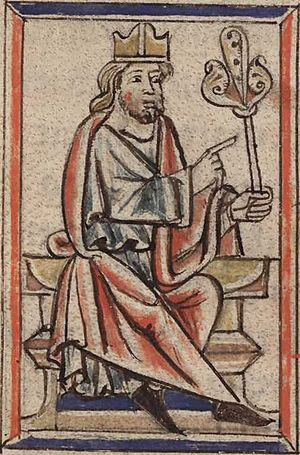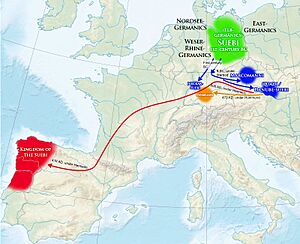Hermeric facts for kids
Hermeric was a powerful king of the Suevi people. He ruled from at least 419 AD until he stepped down in 438 AD. Some historians think he might have become king even earlier, around 406 AD.
Contents
Hermeric's Life and Reign
Early Years and Becoming King
We don't know much about Hermeric before the year 419 AD. That's when he is first mentioned as the king of the Suevi. This happened in the city of Braga, which is in modern-day Portugal. A bishop named Hydatius wrote about this around 470 AD. Another writer, Isidore of Seville, later claimed Hermeric was king from 406 AD, but other old writings don't support this.
Hermeric was a pagan, meaning he followed an ancient religion, not Christianity. He was often an enemy of the mighty Roman Empire throughout his life. Most records say he ruled for 32 years.
Historians believe Hermeric led the Suevi people across the Rhine River in December 406 AD. They traveled with other groups like the Vandals and Alans. They went through Gaul (modern-day France) and over the Pyrenees mountains, finally settling in Hispania (modern-day Spain and Portugal). The Suevi likely stayed in northern Gaul for a few years before moving into a region called Galicia between 409 and 411 AD.
In 411 AD, the land in Iberia was divided among the different barbarian groups. The eastern part of Gallaecia, with its capital Braga, went to the Suevi. The western part went to the Hasdingi Vandals. Later, between 416 and 418 AD, another group called the Visigoths, led by King Wallia, fought against Hermeric on behalf of Rome.
Conflicts and Peace
In 419 AD, Hermeric had a disagreement with Gunderic, the king of the Vandals. The Vandals attacked the Suevi and trapped Hermeric in the Nervasian Mountains. But a Roman general named Asterius stepped in, and the Vandals left. After this, Hermeric kept the peace until the Vandals left Iberia for Africa in 429 AD.
However, in 430 AD, Hermeric began raiding the region of Gallaecia. A local leader named Hydatius traveled to ask for help from a Roman general, Flavius Aëtius. The Roman general sent a commander named Censorius in 432 AD. The people of Gallaecia, from their strong forts, fought back against Hermeric's forces. They caused many losses and took prisoners, which made the Suevi release the Gallaecian families they had captured.
In 435 AD, Hermeric made peace with the Gallaecians. This peace was helped by a bishop named Symphosius. Hermeric even talked directly with the Western Roman Emperor. In 437 AD, Censorius came back for a second time, this time with another commander named Fretimund.
Illness and Abdication
After being sick for seven years, Hermeric decided to step down as king in 438 AD. He passed his kingship to his son, Rechila. It seems that the Suevi kingship was passed down through the family. Hermeric's family line continued to rule until 456 AD.
Around 429 AD, another Suevic leader named Heremigarius was active in a region called Lusitania. Some people think he might have ruled alongside Hermeric for a short time, but there isn't clear proof of this.
See also
 In Spanish: Hermerico para niños
In Spanish: Hermerico para niños
- Cindazunda
| Gallaecia divided | King of Galicia 409–438 |
Succeeded by Rechila |



